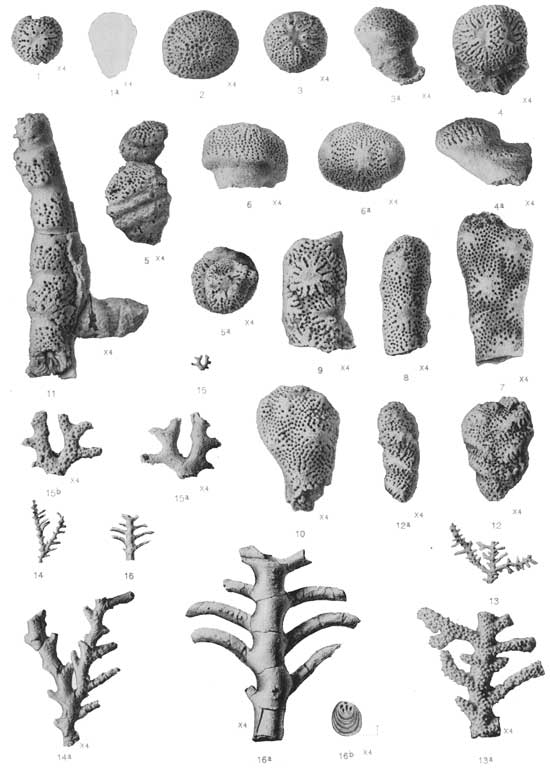
|
Geological Survey Professional Paper 58
The Guadalupian Fauna |
PLATES — PLATE XVIII.
"DARK LIMESTONE," GUADALUPE MOUNTAINS.
|
DOMOPORA? TERMINALIS n. sp. (p. 120). | |
| FIGS. 1 and 1a. |
A small but characteristic specimen. |
| 1. |
Seen from above, X 4. |
| 1a. |
Side view in outline, X 4. "Dark limestone," Guadalupe Point (station 3762b). |
| FIG. 2. |
A specimen in which the terminal macula is obscure. This is probably due to the fact that the outer portion of the zoarium has been broken away. View of the upper end, X 4. "Dark limestone," Guadalupe Point (station 3762b). |
| FIGS. 3 and 3a. |
A characteristic specimen. |
| 3. |
Seen from above, X 4. |
| 3a. |
Side view, X 4. "Dark limestone," Guadalupe Point (station 3762b). |
| FIGS. 4 and 4a. |
A budded specimen in which the second growth has twin maculae. |
| 4. |
Seen from above, X 4. |
| 4a. |
Side view, X 4. "Dark limestone," Guadalupe Point (station 3762b). |
| FIGS. 5 and 5a. |
A specimen in which budding is unusually pronounced. |
| 5. |
Side view, X 4. |
| 5a. |
Seen from above, X 4. "Dark limestone," Guadalupe Point (station 3762b). |
| FIGS. 6 and 6a. |
A specimen with triple maculae, referred with some doubt to this species. It may be an initial colony of D. ocellata. |
| 6. |
Side view, X 4. |
| 6a. |
Seen from above, X 4. "Dark limestone," Guadalupe Point (station 3762b). |
|
DOMOPORA? OCELLATA n. sp. (p. 122). | |
| FIG. 7. |
A fine and very characteristic specimen, apparently showing incipient bifurcation. Side view, X 4. "Dark limestone," Guadalupe Point (station 3762b). |
| FIG. 8. |
A characteristic specimen representing a portion of a branch. Side view, X 4. "Dark limestone," Pine Spring (station 2930). |
| FIG. 9. |
A specimen with projecting maculae, a condition which is possibly connected with silicification and etching. Side view, X 4. "Dark limestone," Pine Spring (station 2930). |
| FIG. 10. |
A tumid specimen referred to this species. The shape is possibly due to incipient branching. Side view, X 4. "Dark limestone," Pine Spring (station 2930). |
|
DOMOPORA? CONSTRICTA n. sp. (p. 123). | |
| FIG. 11. |
The typical specimen. I am not certain whether the apparent branching is a real feature or is due to a parasitic growth. Side view, X 4. "Dark limestone," Pine Spring (station 2930). |
|
DOMOPORA? VITTATA n. sp. (p. 123). | |
| FIGS. 12 and 12a. |
A fragment from near a branching point. |
| 12. |
Side view, X 4. |
| 12a. |
Side view, X 4. "Dark limestone," Pine Spring (station 2930). |
|
ACANTHOCLADIA GUADALUPENSIS n. sp. (p. 149). | |
| FIGS. 13 and 13a. |
The typical specimen, silicified and etched. |
| 13. |
Poriferous side. |
| 13a. |
Portion of the same, X 4, showing the spinose surface. "Dark limestone," Pine Spring (station 2930). |
| FIGS. 14 and 14a. |
Another specimen similarly preserved. |
| 14. |
Nonporiferous side. |
| 14a. |
Same, X 4. The irregularities of surface seen in this view seem to be the result of chalcedonic replacement. "Dark limestone," Pine Spring (station 2930). |
|
ACANTHOCLADIA sp. (p. 152). | |
| FIGS. 15 to 15b. |
A silicified specimen of uncertain affinities. |
| 15. |
Nonporiferous side. |
| 15a. |
Same, X 4. |
| 15b. |
Poriferous side, X 4. "Dark limestone," Guadalupe Point (station 3762e). |
|
ACANTHOCLADIA GUADALUPENSIS n. sp.? (p. 149). | |
| FIGS. 16 to 16b. |
A large specimen showing only the nonporiferous side. |
| 16. |
Nonporiferous side. |
| 16a. |
Same, X 4, showing the nodose pinnules. |
| 16b. |
Cross section, X 3, showing the heavy basal plate. "Dark limestone," Pine Spring (station 2930). |
 |
| Plate XVIII. (click on image for a PDF version) |
| <<< Previous | <<< Contents >>> | Next >>> |
pp/58/plate18.htm
Last Updated: 05-Dec-2008